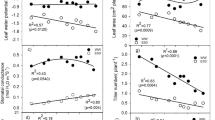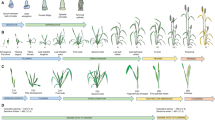Summary
This study sought to identify factors that influence wheat development in the transitional wheat growing zone of northern Syria. Three development factors were studied, intrinsic earliness, and responses to vernalization and to photoperiod. Two sets of wheat were studied, each composed of lines with differing combinations of development factors. Set 1 comprised 20 parental and breeding lines utilized by the CIMMYT/ICARDA facultative and winter wheat breeding program based at Tel Hadya. Set 2 comprised 19 parental and breeding lines utilized by an Australian winter wheat breeding program based at Temora. Field development was recorded in greatest detail at one site. Tel Hadya, using the state of differentiation of the apex of the main tiller of sampled plants. To extend findings, development was also recorded as the time from sowing to ear emergence for later sowings of wheat at Tel Hadya, and in sowings at four other regional sites.
The significance of each development factor was tested in multiple regressions that predicted either stage of apical development at Tel Hadya, or time to ear emergence in all trials. It was found that intrinsic earliness was the major factor associated with development, in both sets of wheat. Response to photoperiod had a much smaller and less consistent effect. Response to vernalization had least effect on development, possibly because low temperature in winter delayed development for a longer period than was required to fully vernalize winter wheats. Our results suggested it may not be directly relevant whether spring or winter wheats are grown in the transitional zone of northern Syria. The desired phenotype for the region, of slow development prior to double ridge, then fast development to ear emergence, cannot be simply achieved from combinations of the three development factors. Selection for improved adaptation to the region must continue to rely on direct field observations.
Similar content being viewed by others
References
FriendD.J.C., J.E.Fisher & V.A.Helsen, 1963. The effect of light intensity and temperature on floral initiation and infloreseence development of Marquis wheat. Can J Bot 41: 1663–1674.
HoshinoT. & M.Tahir, 1987. Relationship between ear primordia development and growth attributes of wheat cultivars in dry areas of North Africa and West Asia. JARQ 21: 226–232.
LandesA. & J.R.Porter, 1989. Comparison of scales used for categorising the development of wheat, barley, rye and oats. Ann Appl Biol 115: 343–360.
PenroseL.D.J., R.H.Martin & C.F.Landers, 1991. Measurement of response to vernalization in Australian wheats with winter habit. Euphytica 57: 9–17.
PenroseL.D.J., M.Mosaad, T.S.Payne, G.Ortiz-Ferrara & H.J.Braun, 1996. Comparison of controls on development in breeding lines from Australian and CIMMYT/ICARDA winter and facultative wheat breeding programs. Austr J Agric Res 47: 1–15.
PugsleyA.T., 1971. A genetic analysis of the spring-winter habit of growth in wheat. Austr. J. Agric. Res. 22: 21–31.
PurdyL.H., W.Q.Loegering, C.F.Konzak, C.J.Peterson & R.E.Allan, 1968. A proposed standard method for illustrating pedigrees of small grain varieties. Crop Sci 8: 405–406.
ScarthR., E.J.M.Kirby & C.N.Law, 1985. Effects of the photoperiod genes Ppd1 and Ppd2 on growth and development of the shoot apex in wheat. Ann Bot 55: 351–359.
Stefany, P., 1991. Daylength and temperature response in durum wheat. Ph.D. Thesis, University of Hohenheim.
VanOosteromE.J. & E.Acevedo, 1992. Adaptation of barley (Hordeum vulgare L.) to harsh Mediterranean environments. II. Apical development, leaf, and tiller appearance. Euphytica 62: 15–27.
Author information
Authors and Affiliations
Rights and permissions
About this article
Cite this article
Penrose, L.D.J., Payne, T.S., Mosaad, M.G. et al. Factors influencing the development of bread wheat plant types to be grown in the ‘transitional zone’ in northern Syria. Euphytica 91, 153–162 (1996). https://doi.org/10.1007/BF00021065
Received:
Accepted:
Issue Date:
DOI: https://doi.org/10.1007/BF00021065




